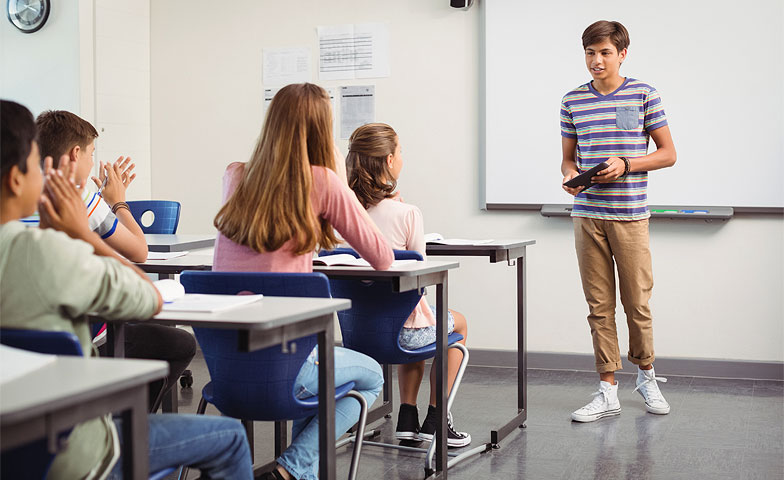A design thinking project to inspire the future generation of leaders
Students today are faced with global issues that impact their lives such as bias, political divisiveness, injustice, and mass shootings. These students have the potential to become a generation of leaders that improve the world for everyone. Educators are in a position to provide students authentic opportunities that demonstrate how each person has the ability to positively impact their community.
The Spotlight Challenge, a school-wide competition, uses design thinking to provide an opportunity for students to discover a passion, solve real world problems, reflect on their strengths, research ideas, and create a call to action that encourages their peers to join them in bringing about positive change.
As the language arts department chair, I implement the unit as a school-wide speech competition but it could be done in a single grade level or classroom environment. Students are given the challenge to design an oral presentation that showcases what they have chosen to spotlight for their peers. The goal of the presentation is to share their ideas and make a positive impact on the community.
Real World Examples
Students begin the unit by exploring real world examples of how others have made a positive change in the world. They are provided examples that include people of diverse backgrounds and ages. This helps build up their confidence that they can make a difference and counters stereotypes as they see children, people of color, immigrants and women taking on leadership roles and making significant positive impacts in our world.
Uncovering a Spotlight
Students then begin brainstorming possible issues, passions, and ideas that they would be interested in presenting to their peers. During this brainstorming process they consider questions such as: What changes do you hope to see in your community or the world? What solution can you create to inspire progress in your community? Once students decide on their topic they take time to research their idea, conduct interviews if applicable, and develop the plan they will present.
Speech Writing
Students then begin to design their speech by writing a claim, a compelling argument, and a call to action. They use ethos, pathos, and logos to appeal to their audience. Students are specifically instructed that their call to action must be something they would be willing to do themselves, and the basis of the idea can’t require others to donate money. By eliminating donations as a solution, it encourages students to craft solutions that would be available to everyone regardless of their ability to contribute financially.
Final Touches
Students use technology to engage the audience, which often helps students feel more confident during their presentation. Students practice their speech many times before presenting it to the class, and with practice they find ways to make it better.
A Competition that Everyone Wins
Every student presents their speech to their language arts class, one winner from each class presents at a grade level competition, and then two students from each grade level advance to present in front of the entire middle school study body. When I introduce the eight finalists to their peers at the school-wide competition, I emphasize that every student in the community has contributed by sharing their ideas, and I encourage students to pursue their plans even if they didn’t advance in the competition.
The Spotlight Challenge is powerful. It encourages students to develop and share ideas. It focuses on ways students can change the world now. It also gives teachers and parents insight into the issues that are important to students. There are always a wide variety of topics shared in the competition such as the power of words, transgender bullying, sexism, Islamophobia, gun law reform, sharing our resources with the broader community, the benefits of taking a walk, and 3-D printing to help those with disabilities. I am consistently in awe of the moral courage shown by middle school students as they share their passions, ideas, and often very personal connections with their peers. The far reaching impact of this opportunity on their future has yet to be determined, but it has helped them develop confidence and the belief that they have the power to make a difference.
Students’ Voice
Lilah P. – “The Spotlight Challenge gives students a sense of power and motivates them to make small changes that can lead to big changes. It shows students their decisions matter, and their actions go a long way.”
Lauren R. – “The challenge also helps the middle school in several ways. For one, it broadens ideas and spreads knowledge across peers, classrooms, and grade levels. It makes issues relevant and uncovers people’s passions and ideas … Giving the Spotlights gave me the courage to do the plays and musical, leading me down the path of theatre, which has been one of the best experiences of my life … the Spotlights enforce and create change in our school … It’s such a wonderful project that expands bigger than the school and much bigger than one kid might think as he or she types up their Spotlight speech. I have thoroughly enjoyed each Spotlight challenge and I will always be thankful for the knowledge and experience it gave me.”
Ellie W. – “Putting your ideas out there may be scary but it is worth it … The Spotlight Challenge helped me to reach out to other people to encourage them to help me with my garden idea. If everyone worked hard to help others, the world would be a better place … A little effort can make a big impact on others.”
